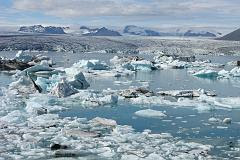
 Iceland is a country unlike any other in our world. It is located
in northern Europe to the southeast of Greenland and the northwest of the
United Kingdom, and is the second largest island in the North Atlantic Ocean.
Iceland is a country unlike any other in our world. It is located
in northern Europe to the southeast of Greenland and the northwest of the
United Kingdom, and is the second largest island in the North Atlantic Ocean.Population In Millions
 With
a population of 313,183 (2011 est.), it has one of the smallest populations.
The capital is Reykjavik and is home to 198,000 Icelanders. Their small
population is especially interesting considering they have a decent land mass
area of 100,250 sq km. This makes their population per square kilometer to be
only 3 persons.
With
a population of 313,183 (2011 est.), it has one of the smallest populations.
The capital is Reykjavik and is home to 198,000 Icelanders. Their small
population is especially interesting considering they have a decent land mass
area of 100,250 sq km. This makes their population per square kilometer to be
only 3 persons.
Unlike most other smaller countries, Iceland is rather
developed. The country is 93% urban with the rural population living mostly on
the coast in fishing communities or on farmlands. Both areas have 100% improved
sanitation. Their population trends are similar to those on the developed side
of the global demographic divide as well. There are an estimated 15 births per
1,000 and 6 deaths per 1,000, making their rate of natural increase a moderate
.9%. Their total population growth rate is estimated at .674%. By mid-2050,
their projected population is a mere 400,000 people. The total fertility rate
is at replacement level with 2.1, and the infant mortality rate is a low 2.5. The
percent of the population with HIV/AIDS is on the low side with .3% for males and
.1% for females. The average life expectancy at birth for the total population
is 81, with 80 being the average for males and 83 for females.
Currently, they
are not facing the issues of having an elder population, but most likely will
in the future. Their elderly support ration as of 2010 was 6 working persons
for every person 65 or older, and the percent of their population ages 15 and
younger was 21% while 65 and older was only 12%. In 2050, the elder support ratio
is projected to be only 2:1.
Economically, Iceland is doing rather well. The
gross national income in PPP per capita is $25,220 as of 2008. The unemployment
rate rose dramatically in 2009, following world-wide economic disaster, from
1.6% to 8%, but is slowly decreasing and was estimated at 7.4% in
2011(statice.is).
The environment is diverse and offers many natural resources.
The environment is diverse and offers many natural resources.
Reykjavik
 |
Skólavörðustígur |
 |
Jokulsarlon lagoon |
 |
| Gullfoss |












